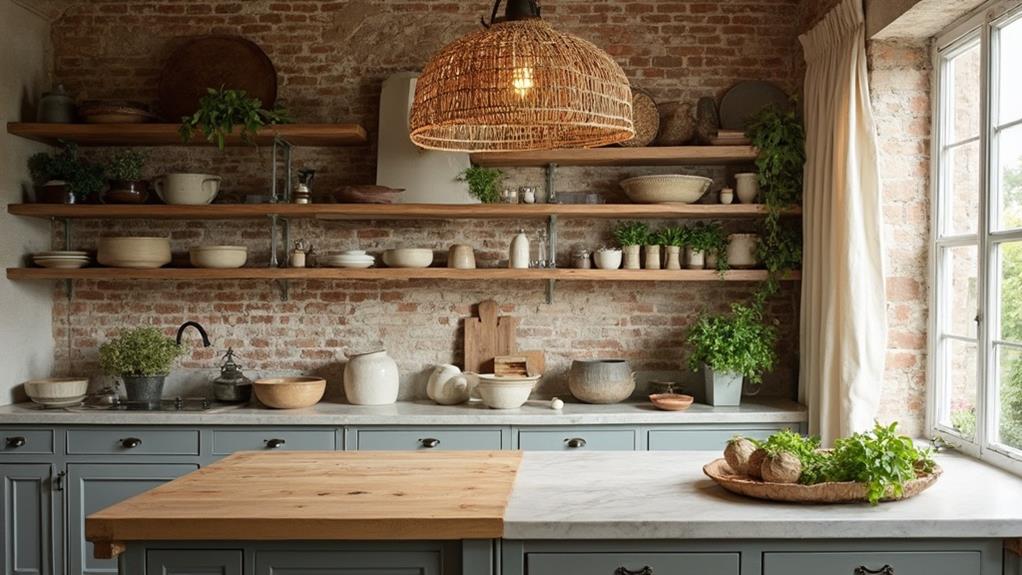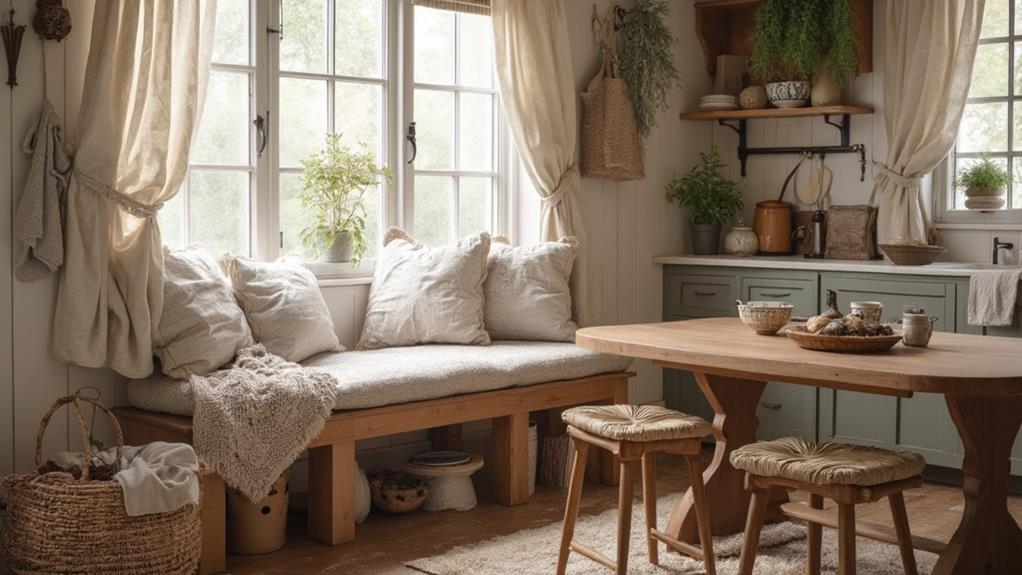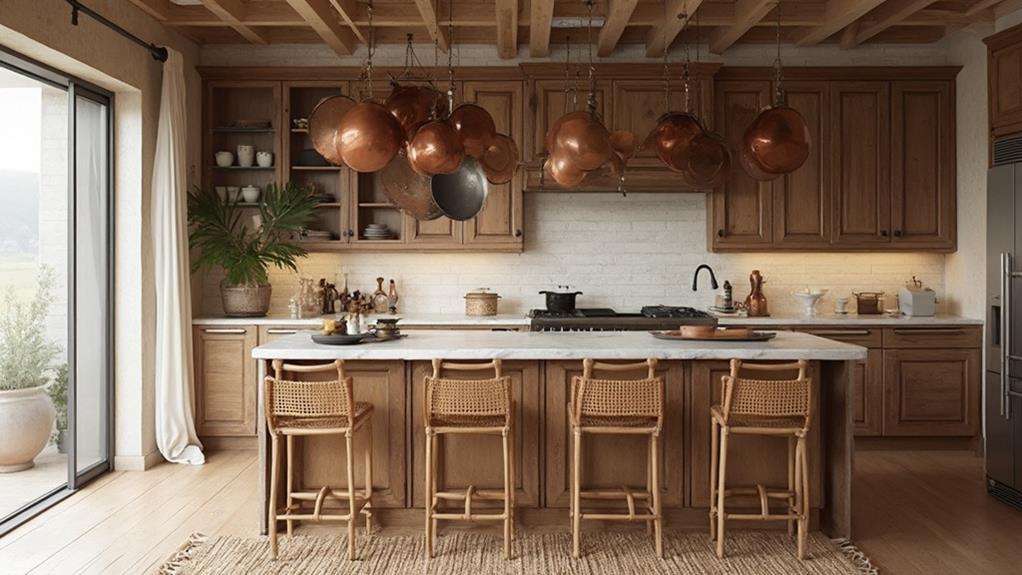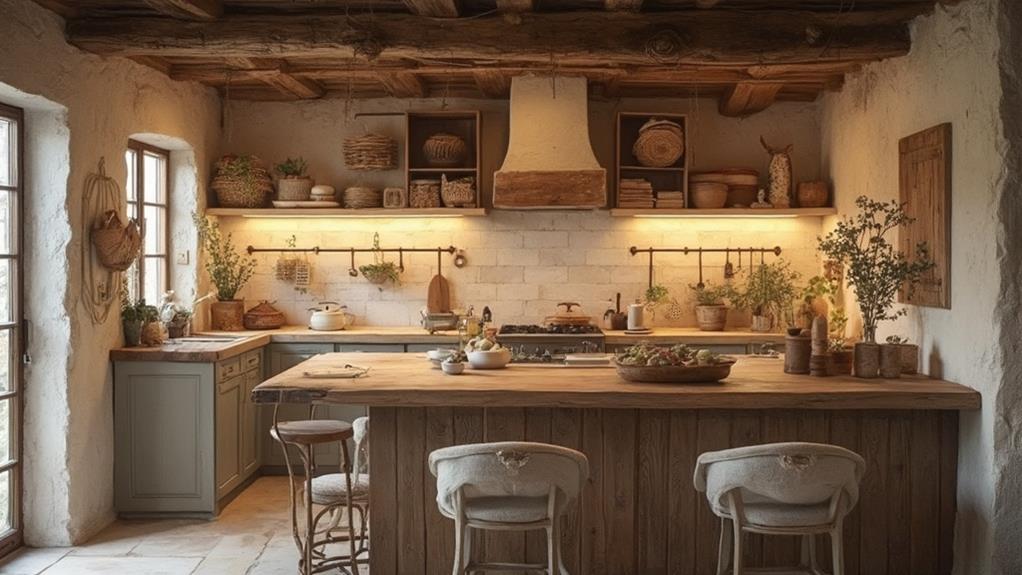Texture plays a crucial role in creating a warm and inviting kitchen. You can incorporate natural elements like wood, stone, and plants to add organic comfort. Textured surfaces, such as subway tiles or honed granite, provide visual interest and depth. Soft furnishings like plush bar stool cushions and flowing curtains introduce coziness. Lighting interacts with textures, creating ambiance and highlighting unique features. By balancing different textures throughout your space, you'll achieve a cohesive and intentional design. From rough-hewn beams to smooth countertops, each element contributes to a rich, tactile experience. Discover how the right mix of textures can transform your kitchen into a welcoming haven.
Natural Elements in Kitchen Design

Many kitchens today are embracing natural elements to create a warm and inviting atmosphere. You'll find that incorporating natural materials can instantly transform your kitchen's look and feel.
Wood is a popular choice, offering a range of options from light oak to rich mahogany. Consider using wooden countertops, open shelving, or exposed ceiling beams to add warmth and character.
Stone is another excellent natural element to introduce. Granite or marble countertops not only provide durability but also bring unique patterns and textures to your space. For a more rustic touch, you might opt for a stone backsplash or flooring.
Don't forget about plants. Adding greenery through potted herbs, hanging plants, or a small indoor garden can breathe life into your kitchen. They'll improve air quality and provide fresh ingredients for your cooking.
Natural fibers like jute or sisal can be incorporated through rugs, curtains, or even light fixtures. These materials add texture and a sense of organic comfort to your kitchen.
Textured Surfaces for Visual Interest
Beyond natural materials, textured surfaces can add another layer of visual interest to your kitchen. Consider incorporating textured tiles for your backsplash, such as subway tiles with a crackle glaze or handmade ceramic tiles with subtle imperfections. These surfaces catch light differently throughout the day, creating a dynamic visual effect.
For countertops, opt for materials with inherent texture like honed granite or leathered quartzite. These finishes not only look stunning but also provide a tactile experience when you're working in the kitchen. Textured cabinet fronts, such as beadboard or shaker-style panels, can add depth and character to your kitchen's overall design.
Don't forget about textured fabrics for window treatments, bar stools, or cushions. Incorporate woven materials, nubby linens, or plush velvets to soften the hard surfaces in your kitchen. You can also introduce texture through accessories like woven baskets, rough-hewn wooden cutting boards, or ceramic vases with interesting glazes. By layering different textures throughout your kitchen, you'll create a rich, inviting space that's visually appealing and comfortable to spend time in.
Fabrics and Soft Furnishings

Fabrics and soft furnishings often play a crucial role in creating a warm and inviting kitchen atmosphere. You'll find that incorporating these elements can soften the hard surfaces typically found in kitchens, adding comfort and visual interest. Consider using plush bar stool cushions, upholstered dining chairs, or a padded bench seat to introduce texture and coziness to your seating areas.
Window treatments are another excellent way to bring fabric into your kitchen. Opt for soft, flowing curtains or Roman shades in natural fibers like linen or cotton. These can add warmth while also controlling light and privacy. Don't overlook the impact of textiles in smaller touches, such as tea towels, oven mitts, and tablecloths. Choose items with interesting patterns or textures to create focal points.
Area rugs can define spaces within your kitchen and add a layer of comfort underfoot. Select durable, easy-to-clean options that complement your overall design. Finally, consider adding throw pillows to bench seating or chairs for an extra pop of color and texture. By thoughtfully incorporating fabrics and soft furnishings, you'll transform your kitchen into a more inviting and comfortable space.
Lighting and Texture Interplay
While fabrics add softness to your kitchen, lighting and texture work together to create depth and visual interest. Consider how light interacts with different surfaces to enhance the overall warmth of your space.
Smooth, glossy finishes like polished granite or stainless steel reflect light, brightening the room and adding a touch of elegance. In contrast, matte or textured surfaces absorb light, creating a cozy, intimate atmosphere.
Strategically place lighting fixtures to highlight textural elements. Under-cabinet lights can accentuate the grain of wooden cabinets or the intricate patterns of a tiled backsplash. Pendant lights over an island or dining area cast shadows that emphasize the texture of rough-hewn wooden beams or exposed brick walls.
Don't forget about natural light. Large windows or skylights not only brighten your kitchen but also showcase the interplay of light and shadow on various textures throughout the day. Use sheer curtains or adjustable blinds to control the amount of sunlight and create different moods.
Balancing Textures for Cohesion

Texture balance is key to creating a cohesive kitchen design. You'll want to mix and match different textures to create visual interest while maintaining harmony. Start by identifying your dominant texture, such as smooth countertops or sleek appliances. Then, introduce contrasting textures to add depth and warmth.
Consider incorporating rough-hewn wood elements, like open shelving or a farmhouse table, to balance glossy surfaces. Textured backsplashes, such as subway tiles or natural stone, can provide a tactile element against flat cabinet fronts. Don't forget about fabrics; add plush bar stool cushions or textured window treatments to soften hard surfaces.
For a cohesive look, repeat textures throughout the space. If you've chosen a marble countertop, echo that texture in smaller accents like a cutting board or utensil holder. Balance shiny metals with matte finishes to avoid overwhelming the eye. Remember, too much of one texture can make your kitchen feel flat, while too many competing textures can create chaos. Aim for a thoughtful mix that feels intentional and inviting, creating a space that's both visually appealing and comfortable to use.
Conclusion
You've now explored the power of texture in crafting a kitchen that's more than just a place to prepare meals. By embracing nature's gifts, playing with surfaces, and adding soft touches, you're creating a space that's truly the heart of your home. Don't forget to let your lighting dance with these textures, and remember, balance is key. With these tips, you'll transform your kitchen from a cold workspace into a warm embrace for family and friends.

